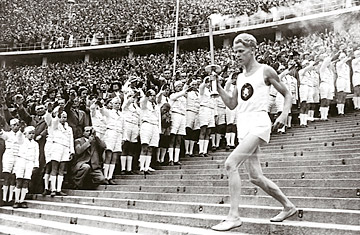
A relay runner carries the Olympic flame before the start of the 1936 Olympic Games in Berlin
Your opinion of the Olympic-torch relay — which kicked off Oct. 22 with a traditional flame-lighting ceremony in Greece — is likely to reflect your opinion of the Olympics themselves. If international cooperation and glory keep you misty-eyed from the opening ceremony through the last television montage, then you'll love the heady symbolism of the torch relay, a "journey of harmony" in which a succession of runners transports a flame lit by the sun's rays from the Games' ancient birthplace to the host site — in 2010, that's Vancouver — over a series of several months.
On the other hand, if you think the competition has been buried under layers of scandal and crass commercialism, you may have never been a fan of the torch relay — and you might be incensed to learn that its roots lie in Nazi Germany. Carl Diem, the secretary-general of the 1936 Berlin Games, pitched the event as a way to infuse the Games with pageantry and buff the mythic image of the Third Reich. That year, on its way from Greece to Germany, the flame passed through Yugoslavia, Hungary, Austria and Czechoslovakia — all of which would be annexed or occupied within a few years.
In the wake of World War II, the relay took on more peaceful overtones. For the 1948 Summer Games in London, the relay's first runner, a Greek army corporal, symbolically removed his military uniform before setting off. Four years later, the first torch relay for Oslo's Winter Olympics started in Morgedal, Norway, the birthplace of skiing pioneer Sondre Norheim. That relay also featured the torch's first trip in an airplane. (For the 1992 Winter Olympics in Albertville, France, the torch got an upgrade, flying from Athens to Paris on the famed Concorde jet.) The relay was first televised in 1960, when CBS broadcast part of the route to Rome.
Host countries often construct an itinerary for the torch relay that showcases points of national pride. On its way to Mexico City in 1968, the torch retraced Christopher Columbus' path to the New World; one of its pit stops was at the Great Pyramid of the Moon in Teotihuacan, where it was incorporated into an Aztec fire ceremony. For the 1988 Olympics in Seoul, torchbearers donned traditional Korean clothing to celebrate the nation's heritage. Twelve years later, on the way to Sydney, an Aboriginal field -hockey star kicked off the domestic leg of the relay from Uluru (Ayers Rock) in the heart of the Australian outback.
Runners are the torch's primary means of transportation, though in recent years the flame has also been carried by boat (Mexico City, 1968; Barcelona, 1992; Atlanta, 1996), horseback (Stockholm, 1956; Atlanta), parachute (Lillehammer, Norway, 1994), snowmobile (Calgary, Canada, 1988) and camel (Sydney, 2000). During its journey to the Atlanta Olympics, astronauts took the torch (though not the flame) into space; a few years later, it dove into the waters of the Great Barrier Reef on its way to Sydney.
The Olympics remain one of the world's most popular events, and relays often attract awestruck crowds of revelers eager for a glimpse of the spectacle. But at times the relay has courted controversy — such as on its way to Beijing in 2008, when demonstrators staged protests against the Chinese government for alleged offenses ranging from domestic human-rights violations to transgressions in Tibet.
On its way to Vancouver, the relay will wind through Greece until Oct. 29, when it will be flown to Canada to begin a laborious 106-day tour across the nation. The torch will be carried by such methods as dogsled, snowmobile, horse and plane. It's a safe bet that the journey will court far less controversy than its Chinese predecessor did. That said, the torch itself has raised some eyebrows. Some observers say the elegantly sculpted white staff bears an unfortunate resemblance to a hand-rolled sample of British Columbia's biggest cash crop. "I'm sure the organizers didn't intend for it to look like a joint, but that's what a lot of people are seeing," Jodie Emery, the editor of Cannabis Culture magazine, told the Toronto Star. If that's the biggest complaint the Vancouver Olympics generate, the organizers will have notched a huge victory. Nevertheless, it's probably best that they keep Michael Phelps a pool's length away from that thing at all times.
